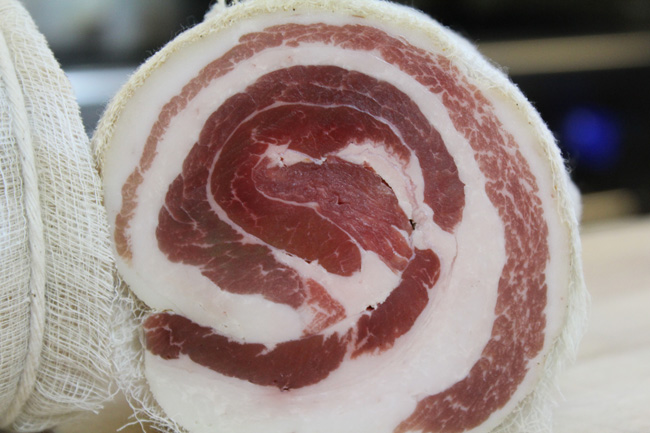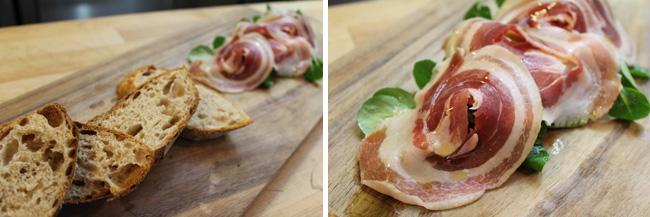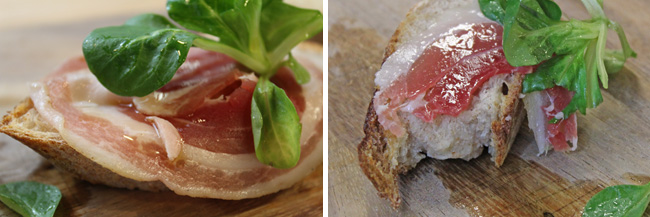What is Pancetta?
 Pancetta in its simplest form is salted and cured pork belly that is native to Italian Cuisine and loved throughout the world. Commonly referred to as "Italian Bacon," pancetta's major difference from it's American counterpart is its lack of smoke. Pancetta is commonly flavored with different seasonings and spices, with each region of Italy, (and chef for that matter), having their own preferential spice blend. Common flavorings include, but are not limited to, black peppercorns, garlic, fennel seed, nutmeg, red chili and coriander. I prefer some less traditional flavors when making my own pancetta at Stella, and so far, the pancetta police hasn't come-a-knockin'. Here's my take:
Pancetta in its simplest form is salted and cured pork belly that is native to Italian Cuisine and loved throughout the world. Commonly referred to as "Italian Bacon," pancetta's major difference from it's American counterpart is its lack of smoke. Pancetta is commonly flavored with different seasonings and spices, with each region of Italy, (and chef for that matter), having their own preferential spice blend. Common flavorings include, but are not limited to, black peppercorns, garlic, fennel seed, nutmeg, red chili and coriander. I prefer some less traditional flavors when making my own pancetta at Stella, and so far, the pancetta police hasn't come-a-knockin'. Here's my take:
How To Make Pancetta

Just with any other culinary pursuit, before one even gets started making pancetta, you must first acquire the highest quality products possible. This is even more imperative when making charcuterie, especially a simple form like pancetta, which doesn't have smoke or prolonged cooking to hide the protein's inferiority if bought from a low quality source. Make sure you purchase pork belly from a reputable farm that raises happy pigs, preferably organically fed and all natural (meaning no hormones added). In fact, one of Europe's biggest secrets to their wonderful charcuterie is their happy, fatty pigs.
Unfortunately, the US pork industry had a multi-decade identity crisis, attempting to breed the fat and flavor out of our pork, in a futile attempt to compete with chicken. You can be the most skilled charcuterie expert in the world, yet if you start with an inferior piece of meat from a poorly raised animal, you may as well be attempting the Starfleet Academy's Kobayashi Maru if you're still expecting to produce a tasty piece of pancetta.
Also, while we're on the subject of ingredients, please make sure that your dried spices are fresh. Just because they're dried doesn't mean they have an indefinite shelf life. If your spices came in a pack of 20 that was given to you as a gift two Christmases ago, you might want to look into buying some new spices.
Spices Used
- Black Peppercorns
- Star Anise
- Coriander
- Fennel Seed
- Mustard Seed
- Orange Zest (definitely not traditional but I like it)
- Sometimes cloves
- Sometimes garlic
- Sometimes nutmeg
The spices really can be mixed to taste, using your nose as a guide. Toast spices in a dry pan until they start to release their essential oils and become aromatic. It is mainly this aroma that will be flavoring your pancetta. Grind toasted spices into a fine powder, making sure you have enough to sprinkle on the bottom side of your pork belly with the majority left over to generously rub into the fat cap as shown in the video.
Now that your are spices ready to go, it's time to talk about salt. Whenever making any type of charcuterie, I prefer to use kosher salt, which is designed to easily adhere to pieces of meat. This makes it ideal for the curing process. To the kosher salt you'll be adding some type of sodium nitrite, whether it be pure sodium nitrite or some sort of curing salt mix that is nitrite cut with sodium chloride (standard salt) to make it easier to measure.
As I demonstrate in the pancetta video, I prefer to use pure sodium nitrite, mixing it with kosher salt as needed. This allows me to easily adjust my nitrite levels from batch to batch, as needed for different charcuterie projects. My formula for the curing salt I use in this pancetta video is:
Kosher Salt Weight X .002 (.2%) = Sodium Nitrite Weight added to my kosher salt.
-For Example-
1,000g Kosher Salt X .002 = 2g Sodium Nitrite. Mix kosher salt and sodium nitrite together and you have your curing salt.
A word of warning; 4g of Sodium Nitrite is considered a lethal dose. This is why many charcuterie books recommend you buy pink curing salt, cut with regular salt and died pink. This makes it easier to measure and less likely that an unsuspecting family member will mix it up with the table salt when taking the initiative, (just to prove that miracles do exist), to fill the family salt shaker. But to put this into perspective, maybe during a full moon at the end of February in a leap year, my entire pancetta recipe will contain 4g of sodium nitrite. This means you will have to consume an entire side of cured pancetta to kill yourself. My humble conjecture is, if you consume a whole log of pancetta in a single sitting, sodium nitrite is the least of your concerns and in a weird twist of irony probably won't kill you because you're body is obviously acclimated to substantial forms of abuse.
If using pink curing salt, Michael Ruhlman, author of Charcuterie, recommends every 450g of kosher salt be mixed with 50g pink curing salt (that's 11% pink salt based on the baker's percentage). For more information on Ruhlman's Pancetta Recipe, see the external links section at the end of this post.

Now that you understand the finer details concerning salting and spicing, the rest of the process for making pancetta is fairly straight forward. Take your happy, well produced pork belly, rub it with toasted and ground spices, and generously salt both sides. Place in your refrigerator and allow to sit in salt mix for about 7-10 days. I prefer to press my pork belly with weights during the salting process, but this is just a matter of taste and it will lead to a slightly saltier end product that is more shelf stable. See video at the top of this page for more information.
After the salting period, the pork belly (which is now technically pancetta), is thoroughly rinsed under cold, running water. Most forms of pancetta available in the United States are rolled, as demonstrated in this video recipe, but that is not always the case. Once rinsed, some people prefer to stick a string through one corner of the pancetta and hang as is. Whether or not the pancetta is rolled is purely a matter of taste and style.
At this point, the pancetta will need to be hung in a cool, dark place with moderate humidity for at least 2-4 weeks before enough moisture has evaporated to intensify the "porky" flavor and make it a finished product. Some forms of pancetta can easily be cured for 3 months or longer before serving.
At Stella, I simply hang the pancetta in my walk-in refrigerator, which has a temperature of around 36°F/2°C, and a relative humidity that hovers around 70%. Generally speaking, an ideal "curing room" is about 60°F/15°C with 60% humidity; at least when hanging pancetta. There are three main things that can possibly ruin your pancetta during the hanging process; temperatures over 70°F/21°C, extreme humidity (both high and low), and direct sunlight.
The temperature will allow for harmful bacteria strains to grow in or on your pancetta, but if using salt mixed with sodium nitrite this is fairly rare. What's more common is that the high temperatures will cause the fat in your pancetta to go rancid, as will direct sunlight. If your humidity is too high then the pancetta will never "dry out" or "cure" properly, and if your humidity is too low or non-existent, then the surface of your pancetta will become dry before its interior moisture can evaporate.
Devoid of temperature and humidity extremes, pancetta can be hung in a cool place out of direct sunlight for the 2-4 weeks required for proper curing. After that, loosely wrap finished pancetta in plastic wrap and store in your refrigerator. If properly stored, you're pancetta will last at least three months in the fridge. If the cut end oxidizes and turns grey slightly, simply trim and discard, and continue to serve as normal.

Related Resources
There are 38 Comments

@ CJ, You nailed it. The
@ CJ,
You nailed it. The salt is pulling out some of the moisture, which mixes with the salt and turns into brine, that is then partially reabsorbed back into the meat. The salt is antimicrobial and jump starts the "drying" process. The prolonged salting is important to ensure there is enough salt in the interior of the meat before rinsing and moving on to the hanging stage.

@ Skflyfish, Yes, in fact
@ Skflyfish,
Yes, in fact some people prefer to to add sugar (sometimes brown) to the salt mix, but you can also rub with honey, molasis or maple sugar. I like where you're heading with this; some of your home made honey would add some awesome complexity to this pancetta recipe. In fact, I think I'm going to give it a shot in a few weeks when I get another batch of pancetta going.
By the way, just finished developing a recipe for some Eastern European Style Brown Bread. Toasted, spread with some room temp butter and drizzled with some of your honey is about as good as it gets.

The sodium nitrite "burn" is
The sodium nitrite "burn" is from the salt reacting with metal. I think he's blowing a little hot air, but that's normal. If you post the method he gave you then I can look at it and see if he's leaving out any steps. Generally speaking, when people are "secretive" or misleading with their recipes, it's usually because it's super-simple to re-create.
The brown bread will be posted in the next week or two.

I would definitely put the
I would definitely put the honey on before the salt. You can also try doing a wet brine that's high in honey content.
Setting your water at 100%, I would start by adding 20-30% honey, 10% salt, .2% sodium nitrite. Bonus points if you inject the brine into the belly. Submerge belly in brine for 3-5 days, rinse, let dry in fridge overnight, smoke, then hang.

@jp888, The air pockets
@jp888,
The air pockets shouldn't be an issue if you roll the pancetta nice and tight as demonstrated in the video. If you're concerned about rolling, you can simply hang the pancetta like slab bacon and you'll be good to go.
You'll know that the pancetta is finished drying when you give it a squeeze and it feels very firm. If the pancetta is "squishy," then it needs more time to dry.
The addition of the sodium nitrite is what makes it possible to eat as is, like I show in the video, but a lot of people will cook the pancetta before using, as it's commonly a salty component in soups, sauces, pasta dishes and vegetable preparations. It's also awesome and pizza and baked into bread.
Let me know if you have any more questions or follow-ups.

No, I don't think its
No, I don't think its overkill; it's just two different approaches. The .2% works for me but there is more of a "window" of the amount one can use when making pancetta or any other form of cured meat.

Sourdough Brown Bread
@ SK,
Here a link to the Sourdough Brown Bread Recipe I mentioned above.

@ Nina, Unfortunately, it
@ Nina,
Unfortunately, it won't work. Salt pork is extremely salty but it is also usually hung as well. Because the belly is also salted, you loose the ability to add your own unique, flavors.
You can buy sodium nitrite online fairly easily. Try chefrubber.com if you want the pure stuff that I use in the video.

Hi Liz, I feel your pain.
Hi Liz, I feel your pain. ;-)
So it sounds like your husband is a squeamish sort of guy when it comes to "raw" or undercooked foods. I would assume he's not that into sushi and probably likes his steak closer to medium, medium-well or even well done.
I would venture to guess that the reason he likes his meat cooked through is because of the whole "bacterial" thing. One of the reasons we cook meat (besides that it tastes good) is to kill bacteria and make it safe to eat. Because we live in a litigious society, most people recommend that you cook your meat to death because they're afraid of the one person out of 100,000 who spends the night on the toilet might sue them for giving bad advice. Yet applying heat is just one of the ways used to make meat safe to eat and isn't close to being the oldest.
Before cooking meat was so convenient, people would cure their meat instead. The salting and drying process would kill any bacteria present and allow them to store their meat without refrigeration and consume without cooking. Now that we have the modern convenience of refrigeration and cooking, we still cure meats because it's delicious. This is why many-a-war has been fought over lands containing salt mines; before refrigeration, people needed salt to cure their meat which allowed them to sustain their families throughout the leaner months.
Outside of that, I really don't know how else to explain it. But a life without jerky, prosciutto di parma, coppa, salumi and ham is hardly one worth living. I'll take my chances with cured meats any day of the week.
Good luck.

This is a first good step.
This is a first good step. Another year or two and we'll have him ordering his steaks mid-rare and eating sashimi with the best of them. But pancetta is a good place to start. Follow this recipe and you'll be on your way.
Let me know if you have any other questions and welcome to Stella Culinary!

Hi Roman, welcome to Stella
Hi Roman, welcome to Stella Culinary. Great question.
Nitrites are what actually do the heavy lifting in the curing process, whether they're added directly to the meat, or they're metabolized into nitrites from nitrates overtime. Either way, it's the actual nitrite which is curing the meat and preventing botulism and other food born illnesses from occurring.
For short term cures like this pancetta, pure sodium nitrite can be used. For long term cures (6 months plus), nitrates are used to provide a steady stream nitrites over a long period of time. Also, the botulinum toxin is a protein produced in anaerobic (no oxygen) environments, so if you wrap the pancetta in cheese cloth and hang it as demonstrated in this video, you won't have an issue with it forming.
Regular salt itself is also a great antimicrobial agent in concentrated amounts. There are many types of classic European style hams that are cured with only sodium chloride (table salt) with no addition of nitrites or nitrates, and allowed to cure for 1-2 years.
For more information on the various types of curing salts, watch my Q&A video entitled "Difference Between Sodium Nitrate, Nitrite, & Pink Curing Salts."
Let me know if you have any more questions.

I don't think you should be
I don't think you should be worried about rolling it. Just start by rolling the edge super tight, just like I do in the video, and you should be fine. However, flat pancetta works great too and no rolling is required. It doesn't make that much difference in flavor, it's just more of a personal preference.

Nope, I'd keep this recipe
Nope, I'd keep this recipe the same.

@ Brian P. Since your
@ Brian P.
Since your original comment got caught in the spam filters, we were able to troubleshoot this thorugh our e-mail conversation, but I posted your original comment for anyone else running into the same issue.
Salt will react with aluminum and other metals over-time, which is what happened in this case. Next time, if you have to use a metal tray, line it with parchment paper or plastic wrap so that the salt and meat doesn't come into contact with the metal.
@ Marvinonme,
Congratulations on your first pancetta attempt. Sounds like everything is going great. Let us know how the finished product turns out.

Hmmm, that's strange. If the
Hmmm, that's strange. If the meat and salt did not come into contact with the metal tray, then I'm absolutely stumped. Don't toss it though; just see how it progresses and if the green tinge gets worse.

Sounds good. Keep me up to
Sounds good. Keep me up to date.

I think prosciutto would be
I think prosciutto would be awesome, but it can be a tad finicky if the exterior dries out too quickly. If you're not in a super dry environment, you should be able to get it to work.
Let me know if you need any help on the project, but it sounds like you know what you're doing.
